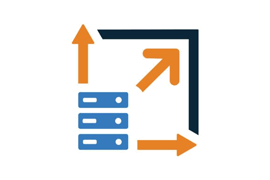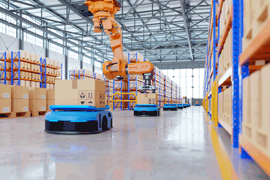The integration of AI and IoT into inventory management systems brings transformative benefits, making processes more efficient, cost-effective, and accurate while reducing the need for manual intervention.
In our previous blog post, How AI and IoT Work Together for Smarter Inventory and Asset Tracking, we explored how these technologies work together to automate asset and inventory tracking, streamline processes, and deliver measurable results. This follow-up discusses the key benefits of AI and IoT integration for inventory management, and examines the future trends shaping the industry.
Benefits of Using AI and IoT in Inventory Management
Increased Operational Efficiency
Implementing AI and IoT in the inventory management process greatly reduces the time and effort needed for maintaining accurate stock levels, inventory replenishment, allocation and billing. IoT inventory system can continuously track and update stock levels, eliminating the need for frequent manual checks. This automation results in accurate stock counts, and minimizes the risk of errors, preventing incorrect data entries or unnoticed stock discrepancies.AI algorithms further streamline operations by optimizing warehouse picking routes, organizing inventory layout, and automating reordering tasks.

Cost Savings
AI and IoT technologies bring serious cost savings to businesses by optimizing stock levels, enhancing demand forecasting, and reducing potential losses. With AI-driven demand forecasting, businesses can achieve far greater accuracy than with the traditional inventory management methods, which helps reduce overstock and stockout expenses.IoT data on stock levels, product movement, and demand allows AI inventory systems to recommend optimal stock quantities, thereby minimizing excess inventory and cutting holding costs.
In addtion, IoT sensors can continuously monitor environmental conditions and security, proactively protecting inventory from spoilage, theft, and damage.
Improved Decision Making
AI-based data analytics and predictive capabilities gives companies the bases for informed decision-making. By analyzing data collected from IoT tags and sensors, AI provides actionable insights into stock trends, demand patterns, and bottlenecks in the process.
Information provided by IoT and AI inventory system allows managers to respond quickly to changes in demand. Managers can promptly identify and resolve any issue before they impact customer satisfaction or incur extra costs.
Enhanced Customer Satisfaction
An efficient inventory system powered by AI and IoT leads to better product availability and faster delivery times, contributing to the timely projects completion and a positive customer experience.Scalability and Flexibility
AI and IoT technologies give companies the flexibility needed to expand or adjust operations as business demands evolve, minimizing growing pains. IoT sensors and AI-driven inventory management systems can scale up efficiently to handle increased product volumes, new locations, and greater operational complexity.
By integrating AI and IoT technologies into the inventory management systems, companies are not only able to achieve operational efficiency and cost savings, but they are also better equipped to respond to customer needs and market changes in real time. This adaptability ensures that inventory management systems remain agile, future-ready, and responsive, supporting businesses as they expand and evolve.
Challenges and Considerations in Implementing IoT and AI For Inventory Management
While AI and IoT offer remarkable benefits for inventory management, they also come with certain challenges that you need to consider. Implementing these technologies requires a thoughtful approach to manage costs, ensure data security, and integrate with existing systems. Here's an overview of the main challenges and how they might impact deployment.Initial Investment In IoT and AI System
Implementing AI and IoT in inventory management requires upfront investment. Costs include the purchase and installation of IoT hardware (BLE tags, gateways, sensors), AI software solutions, and possibly updates to the company IT infrastructure. For many companies, particularly small enterprises, the initial costs might seem too high. But even for the small businesses the long-term operational savings can justify the initial investment. Our general advice would be to start small by implementing a pilot project, and then scaling up across the organization.Data Security and Privacy Concerns
Data collected by IoT devices might create potential security and privacy risks. IoT sensors monitor and share continuous streams of data, including product movements, stock levels, and employee actions within a warehouse. This data might be vulnerable to cyber-attacks if not properly secured.Companies should invest in cybersecurity measures to protect against data breaches and unauthorized access. These include data encryption, secure access controls, and routine monitoring of data flows. For the European customers, ensuring compliance with data privacy regulations, like The General Data Protection Regulation (GDPR), is also important, especially if IoT devices capture any personal or employee-related information.
Integration with Existing Systems
Legacy software can pose challenges when integrating with the modern inventory systems that implement AI and IoT. Older software may lack the compatibility or processing power needed to work seamlessly with IoT data streams or AI-driven analysis, making it difficult to achieve a unified and efficient system. You may need to take into account time and effort required for the integration of the new and old systems, if such integration is required.
In some cases you might need to upgrade or replace legacy systems to accommodate new technologies. Adopting open APIs and modular solutions that allow gradual integration can help ease the transition process.
How Companies Overcome These Challanges: General Electric (GE)
General Electric faced notable challenges when implementing IoT and AI solutions in its supply chain and inventory management. GE aimed to improve asset tracking, predictive maintenance, and inventory efficiency, but encountered significant hurdles with system integration and the need for a large-scale data infrastructure overhaul. Legacy systems in certain facilities couldn't initially support the data-intensive requirements of IoT devices, and finding skilled personnel to manage these new technologies was a challenge.GE addressed these challenges by creating a digital platform specifically for IoT and AI integration, known as Predix. The platform was designed to unify data from diverse IoT devices across different locations, ensuring compatibility with existing operations.
Today, GE leverages this integrated platform to monitor assets in real time. The system allowed GE to optimize maintenance schedules and improve inventory forecasting, transforming its supply chain into a more responsive and efficient system.
These challenges highlight the need for careful planning, investment, and personnel training to fully realize the benefits of AI and IoT in inventory management. By addressing these factors proactively, companies can create a foundation for a successful digital transformation in their inventory systems.
Future Trends and the Outlook for IoT and AI in Inventory Management
As AI and IoT continue to evolve, their applications in inventory management will grow and become even more advanced, offering businesses unprecedented levels of efficiency, precision, and automation. In this section, we explore the key trends shaping the future of inventory management using these advanced technologies.Autonomous Warehousing
Autonomous warehousing is a growing trend. These warehouses are operated with minimal human intervention, relying on AI inventory system, robotics, and IoT devices. With the development of AI-powered robots, drones, and autonomous vehicles, warehouses will become fully automated.Common warehouse tasks such as product picking, sorting, and packaging will be done with minimal human intervention. Fully automated warehouses lead to much faster order fulfillment, lower labor costs, and higher accuracy. IoT sensors will monitor every aspect of the warehouse, from product location to environmental conditions, while AI systems will optimize workflows and predict maintenance needs for machines.
This trend is already being tested in companies like Amazon, which uses Kiva robots for automated inventory management and order fulfillment. Another example is Ocado, an online grocery retailer. They have built one of the world's most advanced fully automated warehouses, where robots pick and pack groceries with minimal human intervention. IoT devices and AI algorithms help manage stock levels, optimize picking routes, and ensure orders are fulfilled with high accuracy and speed.
Advanced Predictive Analytics
AI's predictive capabilities will continue to evolve, becoming even more sophisticated. Future AI models will integrate deeper learning techniques and process larger datasets, enabling them to make highly dynamic and real-time predictions about inventory needs. These predictive models will not only forecast demand with greater accuracy, but will also adjust based on shifting trends, external factors (e.g., weather, promotions), and real-time data.Advanced predictive analytics will allow companies to make informed decisions about stock levels, order quantities, and replenishment schedules. AI will provide businesses with hyper-localized demand forecasts, ensuring that inventory aligns precisely with customer preferences and purchasing behaviors.

Retail giants like Walmart and Target are already using advanced AI analytics to predict demand. Future improvements in these systems will enable even more granular insights, reducing waste and ensuring better product availability across all locations.
Smart Shelving and Robotics
As IoT and AI continue to evolve, the concept of smart shelving will expand, integrating with robots and other automated systems for greater inventory efficiency. IoT-enabled smart shelves will monitor product levels, track movement, and send alerts when items need to be restocked. Robots will assist in restocking and picking from these shelves, further automating warehouse and retail store operations.Combining smart shelving with robotic systems will improve inventory accuracy, reduce labor costs, and streamline the replenishment process. In retail settings, smart shelves can track customer interactions with products, providing valuable insights into buying patterns and preferences. In warehouses, robots can assist with shelf restocking based on AI predictions of future demand, making the entire process more dynamic and responsive.
For example, Bossa Nova Robotics has deployed smart shelving robots in several Walmart stores to scan shelves in real time, updating inventory levels and checking for misplaced or out-of-stock items. These robots use AI to navigate aisles, interact with IoT sensors, and assist in restocking shelves with minimal human intervention.

5G Integration
The rollout of 5G technology will dramatically enhance the capabilities of IoT devices in inventory management. 5G's high-speed, low-latency connectivity will enable faster, more reliable data transmission between IoT sensors and central cloud systems. This is especially important for applications requiring real-time updates, such as live inventory tracking, robotics, and autonomous systems.With 5G, IoT devices in warehouses and stores will be (and already are) able to transmit data instantly, allowing for near real-time visibility into inventory levels and operational status. This will also make it easier to deploy large networks of IoT devices across expansive facilities without compromising speed or reliability.
Real-time decision-making, predictive maintenance, and fast adjustments to demand forecasts will all benefit from the enhanced capabilities that 5G provides. For example, Verizon and Qualcomm are working with FedEx and UPS to integrate 5G technology into their logistics and inventory systems. 5G enables faster data exchanges between warehouses, sensors, and delivery vehicles, improving overall operational efficiency and enabling real-time decision-making for inventory management.
Blockchain and Security
As IoT devices generate vast amounts of data, securing that data becomes increasingly critical. Blockchain, a decentralized and immutable ledger technology, is gaining attention for its potential to enhance data security and transparency in inventory management. Blockchain can help track and verify the movement of goods across the supply chain, ensuring that data from IoT devices is authentic and tamper-proof.Blockchain integration provides an added layer of security for inventory data, reducing the risk of cyber-attacks and fraud. It also ensures greater transparency in the supply chain by allowing stakeholders to track the origin and movement of products from manufacturer to consumer. This is particularly valuable for industries like pharmaceuticals and food, where product provenance and safety are critical.
Walmart has already started using blockchain technology to track the origin and journey of products, particularly fresh produce. The integration of blockchain with IoT devices allows Walmart and other retailers to verify the authenticity and condition of goods as they move through the supply chain, providing additional layers of security and trust for both businesses and consumers.
As AI and IoT technologies evolve, the future of inventory management looks incredibly dynamic, with greater automation, real-time capabilities, and enhanced security. Companies that embrace these trends will be able to scale their operations more efficiently, improve decision-making, and enhance customer satisfaction — securing their place in the increasingly competitive, data-driven marketplace.
Are you currently using IoT and AI in your inventory management processes? What challenges or successes have you experienced? We'd love to hear about your experiences, questions, or thoughts on how these technologies are reshaping the way we manage inventory. Feel free to share your insights or reach out if you have any questions about implementing IoT and AI solutions in your business. Together, we can explore how the future of inventory management will continue to evolve!
